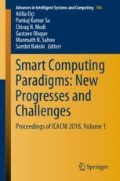Abstract
Electrocardiography (ECG or EKG) is a medical test that is heavily used to assess human heart condition and investigate a large set of cardiac diseases. Automated ECG analysis has become a task of increased clinical importance since it can aid physicians in improved diagnosis. Most of the automated ECG analysis techniques require first identifying the onset and offset locations of its fiducial points and characteristic waves. Two of the important characteristic waves are P and T waves. They mark the beginning and end of an ECG cycle, respectively. In this paper, a fast technique is proposed that can segment ECG signals by accurately identifying the P and T waves. In this work, we evaluate the performance of our model on standard QT database (Laguna et al. Comput Cardiol 24:673–676, 1997 [1]). We achieved high accuracies above 99% and 97% while detecting P waves and T waves respectively.
Access this chapter
Tax calculation will be finalised at checkout
Purchases are for personal use only
References
Laguna, P., Mark, R.G., Goldberger, A.L., Moody, G.B.: A database for evaluation of algorithms for measurement of QT and other waveform intervals in the ECG. Comput. Cardiol. 24, 673–676 (1997)
Moody, G., Mark, R.: The impact of the MIT-BIH Arrhythmia database. IEEE Eng. Med. Biol. Mag. 20, 45–50 (2001)
Taddei, A., Distante, G., Emdin, M., Pisani, P., Moody, G., Zeelenberg, C., Marchesi, C.: The European ST-T database: standard for evaluating systems for the analysis of ST-T changes in ambulatory electrocardiography. Eur. Heart J. 13, 1164–1172 (1992)
Pan, J., Tompkins, W.: A real-time QRS detection algorithm. IEEE Trans. Biomed. Eng. BME-32, 230–236 (1985)
Cuiwei, L., Chongxun, Z., Changfeng, T.: Detection of ECG characteristic points using wavelet transforms. IEEE Trans. Biomed. Eng. 42, 21–28 (1995)
Coast, D., Stern, R., Cano, G., Briller, S.: An approach to cardiac arrhythmia analysis using hidden Markov models. IEEE Trans. Biomed. Eng. 37, 826–836 (1990)
Gritzali, F., Frangakis, G., Papakonstantinou, G.: Detection of the P and T waves in an ECG. Comput. Biomed. Res. 22, 83–91 (1989)
Lagerholm, M., Peterson, C., Braccini, G., Edenbrandt, L., Sornmo, L.: Clustering ECG complexes using Hermite functions and self-organizing maps. IEEE Trans. Biomed. Eng. 47, 838–848 (2000)
Goutas, A., Ferdi, Y., Herbeuval, J., Boudraa, M., Boucheham, B.: Digital fractional order differentiation-based algorithm for P and T-waves detection and delineation. ITBM-RBM 26, 127–132 (2005)
Laguna, P., Jané, R., Caminal, P.: Automatic detection of wave boundaries in multilead ECG signals: validation with the CSE database. Comput. Biomed. Res. 27, 45–60 (1994)
Hoffman, B.F., Cranefield, P.F.: Electrophysiology of the Heart. McGraw-Hill, Blakiston Division (1960)
Joshi, A., Tomar, M.: A review paper on analysis of electrocardiograph (ECG) signal for the detection of arrhythmia abnormalities. Int. J. Adv. Res. Electr. Electron. Instrum. Eng. 03, 12466–12475 (2014)
Thakor, N., Zhu, Y.: Applications of adaptive filtering to ECG analysis: noise cancellation and arrhythmia detection. IEEE Trans. Biomed. Eng. 38, 785–794 (1991)
Hamilton, P.: Open source ECG analysis. Comput. Cardiol. IEEE, 101–104 (2002)
Elgendi, M., Eskofier, B., Abbott, D.: Fast T wave detection calibrated by clinical knowledge with annotation of P and T waves. Sensors 15, 17693–17714 (2015)
Badilini, F.F.: Method and apparatus for extracting optimum Holter ECG reading. U.S. Patent 8,560,054, issued 15 Oct 2013 (2013)
Author information
Authors and Affiliations
Corresponding author
Editor information
Editors and Affiliations
Rights and permissions
Copyright information
© 2020 Springer Nature Singapore Pte Ltd.
About this paper
Cite this paper
Bisharad, D., Dey, D., Bhowmick, B. (2020). A Fast Method for Segmenting ECG Waveforms. In: Elçi, A., Sa, P., Modi, C., Olague, G., Sahoo, M., Bakshi, S. (eds) Smart Computing Paradigms: New Progresses and Challenges. Advances in Intelligent Systems and Computing, vol 766. Springer, Singapore. https://doi.org/10.1007/978-981-13-9683-0_22
Download citation
DOI: https://doi.org/10.1007/978-981-13-9683-0_22
Published:
Publisher Name: Springer, Singapore
Print ISBN: 978-981-13-9682-3
Online ISBN: 978-981-13-9683-0
eBook Packages: Intelligent Technologies and RoboticsIntelligent Technologies and Robotics (R0)

